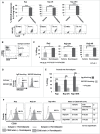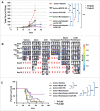Romidepsin alone or in combination with anti-CD20 chimeric antigen receptor expanded natural killer cells targeting Burkitt lymphoma in vitro and in immunodeficient mice
- PMID: 28932644
- PMCID: PMC5599075
- DOI: 10.1080/2162402X.2017.1341031
Romidepsin alone or in combination with anti-CD20 chimeric antigen receptor expanded natural killer cells targeting Burkitt lymphoma in vitro and in immunodeficient mice
Abstract
Facilitating the development of alternative targeted therapeutic strategies is urgently required to improve outcome or circumvent chemotherapy resistance in children, adolescents, and adults with recurrent/refractory de novo mature B-cell (CD20) non-Hodgkin lymphoma, including Burkitt lymphoma (BL). Romidepsin, a histone deacetylase inhibitor (HDACi), has been used to treat cutaneous T-cell lymphoma. We have demonstrated the significant anti-tumor effect of anti-CD20 chimeric antigen receptor (CAR) modified expanded peripheral blood natural killer (exPBNK) against rituximab-sensitive and -resistant BL. This study examined the anti-tumor activity of romidepsin alone and in combination with anti-CD20 CAR exPBNKs against rituximab-sensitive and -resistant BL in vitro and in vivo. We found that romidepsin significantly inhibited both rituximab-sensitive and -resistant BL cell proliferation in vitro (P < 0.001) and induced cell death in rituximab-sensitive Raji (P < 0.001) and cell cycle arrest in rituximab-resistant Raji-2R and Raji-4RH (P < 0.001). Consistent with in vitro observations, we also found romidepsin significantly inhibited the growth of rituximab-sensitive and -resistant BL in BL xenografted NSG mice. We also demonstrated that romidpesin significantly induced the expression of Natural Killer Group 2, Member D (NKG2D) ligands MICA/B in both rituximab-sensitive and -resistant BL cells (P < 0.001) resulting in enhancement of exPBNK in vitro cytotoxicity through NKG2D. Finally, we observed the combination of romidepsin and anti-CD20 CAR exPBNK significantly induced cell death in BL cells in vitro, reduced tumor burden and enhanced survival in humanized BL xenografted NSG mice (p < 0.05). Our data suggests that romidepsin is an active HDAC inhibitor that also potentiates expanded NK and anti-CD20 CAR exPBNK activity against rituximab-sensitive and -resistant BL.
Keywords: anti-CD20 chimeric antigen receptor; expanded Natural Killer Cells; rituximab sensitive and resistant Burkitt Lymphoma; romidepsin; targeted immunotherapy.
Figures







Similar articles
-
Targeting CD20+ Aggressive B-cell Non-Hodgkin Lymphoma by Anti-CD20 CAR mRNA-Modified Expanded Natural Killer Cells In Vitro and in NSG Mice.Cancer Immunol Res. 2015 Apr;3(4):333-44. doi: 10.1158/2326-6066.CIR-14-0114. Epub 2014 Dec 9. Cancer Immunol Res. 2015. PMID: 25492700
-
Novel cytokine-antibody fusion protein, N-820, to enhance the functions of ex vivo expanded natural killer cells against Burkitt lymphoma.J Immunother Cancer. 2020 Oct;8(2):e001238. doi: 10.1136/jitc-2020-001238. J Immunother Cancer. 2020. PMID: 33109629 Free PMC article.
-
Obinutuzumab (GA101) compared to rituximab significantly enhances cell death and antibody-dependent cytotoxicity and improves overall survival against CD20(+) rituximab-sensitive/-resistant Burkitt lymphoma (BL) and precursor B-acute lymphoblastic leukaemia (pre-B-ALL): potential targeted therapy in patients with poor risk CD20(+) BL and pre-B-ALL.Br J Haematol. 2015 Dec;171(5):763-75. doi: 10.1111/bjh.13764. Epub 2015 Oct 16. Br J Haematol. 2015. PMID: 26471982
-
Combinatorial immunotherapy of N-803 (IL-15 superagonist) and dinutuximab with ex vivo expanded natural killer cells significantly enhances in vitro cytotoxicity against GD2+ pediatric solid tumors and in vivo survival of xenografted immunodeficient NSG mice.J Immunother Cancer. 2021 Jul;9(7):e002267. doi: 10.1136/jitc-2020-002267. J Immunother Cancer. 2021. PMID: 34244307 Free PMC article.
-
Cellular and molecular signal transduction pathways modulated by rituximab (rituxan, anti-CD20 mAb) in non-Hodgkin's lymphoma: implications in chemosensitization and therapeutic intervention.Oncogene. 2005 Mar 24;24(13):2121-43. doi: 10.1038/sj.onc.1208349. Oncogene. 2005. PMID: 15789036 Review.
Cited by
-
Broadening the horizon: potential applications of CAR-T cells beyond current indications.Front Immunol. 2023 Nov 27;14:1285406. doi: 10.3389/fimmu.2023.1285406. eCollection 2023. Front Immunol. 2023. PMID: 38090582 Free PMC article. Review.
-
Additional possibilities of chimeric antigen receptor T-cells in B-cell lymphoma: combination therapy.Transl Cancer Res. 2020 Nov;9(11):7310-7322. doi: 10.21037/tcr-20-72. Transl Cancer Res. 2020. PMID: 35117332 Free PMC article. Review.
-
Chimeric antigen receptor engineered natural killer cells for cancer therapy.Exp Hematol Oncol. 2023 Aug 10;12(1):70. doi: 10.1186/s40164-023-00431-0. Exp Hematol Oncol. 2023. PMID: 37563648 Free PMC article. Review.
-
Genetic and epigenetic modification of human primary NK cells for enhanced antitumor activity.Semin Hematol. 2020 Oct;57(4):201-212. doi: 10.1053/j.seminhematol.2020.11.006. Epub 2020 Nov 19. Semin Hematol. 2020. PMID: 33256913 Free PMC article.
-
Chimeric antigen receptor natural killer (CAR-NK) cell design and engineering for cancer therapy.J Hematol Oncol. 2021 May 1;14(1):73. doi: 10.1186/s13045-021-01083-5. J Hematol Oncol. 2021. PMID: 33933160 Free PMC article. Review.
References
-
- Pinkerton R, Cairo MS. Childhood Non-Hodgkin Lymphoma In: Cairo MS, Perkins SL, eds. Hematological Malignancies in Children, Adolescents and Young Adults. Singapore: World Scientific, 2012:299-328; ISBN:978-981-4299-60-2; https://doi.org/ 10.1142/9789814299619_0016 - DOI
-
- Cairo MS, Gerrard M, Sposto R, Auperin A, Pinkerton CR, Michon J, Weston C, Perkins SL, Raphael M, McCarthy K, et al.. Results of a randomized international study of high-risk central nervous system B non-Hodgkin lymphoma and B acute lymphoblastic leukemia in children and adolescents. Blood 2007; 109:2736-43; PMID:17138821; https://doi.org/ 10.1182/blood-2006-07-036665 - DOI - PMC - PubMed
-
- Gerrard M, Cairo MS, Weston C, Auperin A, Pinkerton R, Lambilliote A, Sposto R, McCarthy K, Lacombe MJ, Perkins SL, et al.. Excellent survival following two courses of COPAD chemotherapy in children and adolescents with resected localized B-cell non-Hodgkin's lymphoma: results of the FAB/LMB 96 international study. Br J Haematol 2008; 141:840-7; PMID:18371107; https://doi.org/ 10.1111/j.1365-2141.2008.07144.x - DOI - PubMed
-
- Cairo MS, Sposto R, Gerrard M, Auperin A, Goldman SC, Harrison L, Pinkerton R, Raphael M, McCarthy K, Perkins SL, et al.. Advanced stage, increased lactate dehydrogenase, and primary site, but not adolescent age (>/ = 15 years), are associated with an increased risk of treatment failure in children and adolescents with mature B-cell non-Hodgkin's lymphoma: results of the FAB LMB 96 study. J Clin Oncol 2012; 30:387-93; PMID:22215753; https://doi.org/ 10.1200/JCO.2010.33.3369 - DOI - PMC - PubMed
-
- Hoelzer D, Walewski J, Dohner H, Viardot A, Hiddemann W, Spiekermann K, Serve H, Dührsen U, Hüttmann A, Thiel E, et al.. Improved outcome of adult Burkitt lymphoma/leukemia with rituximab and chemotherapy: report of a large prospective multicenter trial. Blood 2014; 124:3870-9; PMID:25359988; https://doi.org/ 10.1182/blood-2014-03-563627 - DOI - PMC - PubMed
Publication types
LinkOut - more resources
Full Text Sources
Other Literature Sources
